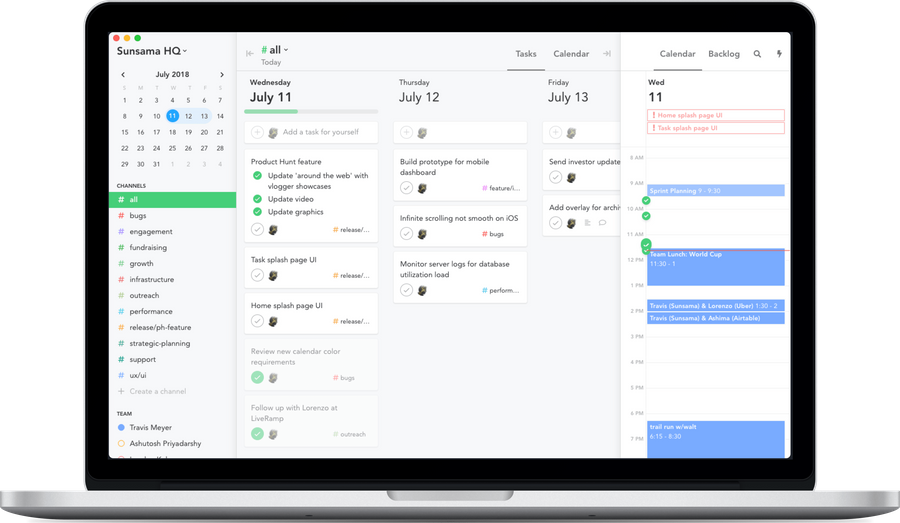I have done well to stay away from new productivity apps the past couple of years. I'm still using Things as my main repository of projects and AoR (areas of responsibility) — this has not changed since Things 3 arrived and I wrote about it for The Sweet Setup.
The biggest change in recent years has been the use of pen and paper for daily planning and tracking. I still do this today (currently with a Do Journal from Baron Fig, but I'm also looking forward to Analog from Ugmonk).
However, I recently invested some time into trying a new entrant in this category. Not pen and paper, but an application. It's called Sunsama.
I heard about this earlier in the summer, but it was invite only to start and I chose not to act on the invite to a private demo from the team. But when my coworker Amy mentioned using it, I gave it a second look. And it brought enough benefit that I keep going back to it.
First, what's good about it? Well, it's not the nice design or the focus on integrations. Instead, it's the baked-in workflow. Take that away and it's just like so many other options available today.
There's a reason it's described this way on their home page:
The daily planner for elite professionals
Elite aside, this is a good description — it's a tool for planning your time. Rather than be a place to house all your tasks, Sunsama is just focused on what you want to get done today. That's a powerful habit to get into.
And what's really nice about the tool is the workflow. Each day, you start by identifying what you want to get done today. Tasks from the day before that are still not completed are available to be assigned to today. But you can also add new tasks that come to mind or are coming due.
One nice aspect of this service is that you can keep your projects documented elsewhere. Sunsama works nicely with your existing tools. You can add tasks to your day manually, or you can use one of the integrations to see your work and drag and drop the appropriate tasks.
If you use the integrated service, this means Sunsama can place nicely with team collaboration, something that has been an issue for GTD folks who like to use tools like Things or Omnifocus.
Good habits
The workflow is based around this daily flow of planning only the things you think you can get done each day. But there are a few others that are implicit in its design.
The first is time-blocking. Your calendar is a major piece of focus in Sunsama. While you collate a list of tasks each day, you can use your emails or your calendar for the day to create those tasks. But you can also choose to view the app in two different ways: with your tasks in focus and the calendar in the sidebar, or the other way around. If you use the latter, you can drag and drop each task into your calendar, similar to the process people like Cal Newport or Shawn Blanc advocate.

The second is tracking where your time goes. At any point, you can open a task and then put it into focus. This functionality includes a timer that you can click. Now you're able to record how long your tasks take you.
Of course, time tracking is always an activity ripe for inaccuracy as you often switch between different tasks (at least, I do). But that's exactly the kind of thing Sunsama is aimed to help you with — to focus on one thing at a time. And if you can manage that, you have this useful bit of information about how long things take.
Related to time tracking, Sunsama also lets you use the Pomodoro technique. The tracker and focus mode include the option to take a Break. The timer will switch to use a different title and is set to a default amount of time.
And when the week comes to an end, the app encourages you to perform a weekly review. The UI for this is not robust — it simply asks you three contemplative questions. However, encouraging the habit is a good addition, and you could use this to perform a full fledged check of your current situation.
Last, Sunsama starts to tie all these things together. It also makes tracking progress and reporting easier. In conjunction with the timing functionality, you can assign each task to a channels (think of categories or tags). If you do this effectively, the weekly review functionality shows you how your time was spent across each channel.
As well, at the end of each day's planning session, you are given a summary of what you've done and what you have planned for the day. This summary can be posted automatically to Slack (if you integrate it), or you can copy and paste it into the tool of your choice. For teams using an app like Geekbot (or some other automated daily stand-up replacement), the is also pretty slick.
At any rate, if this sounds at all enticing to you, use my referral link to check it out. I’ve been converted and am happily paying for the tool.
